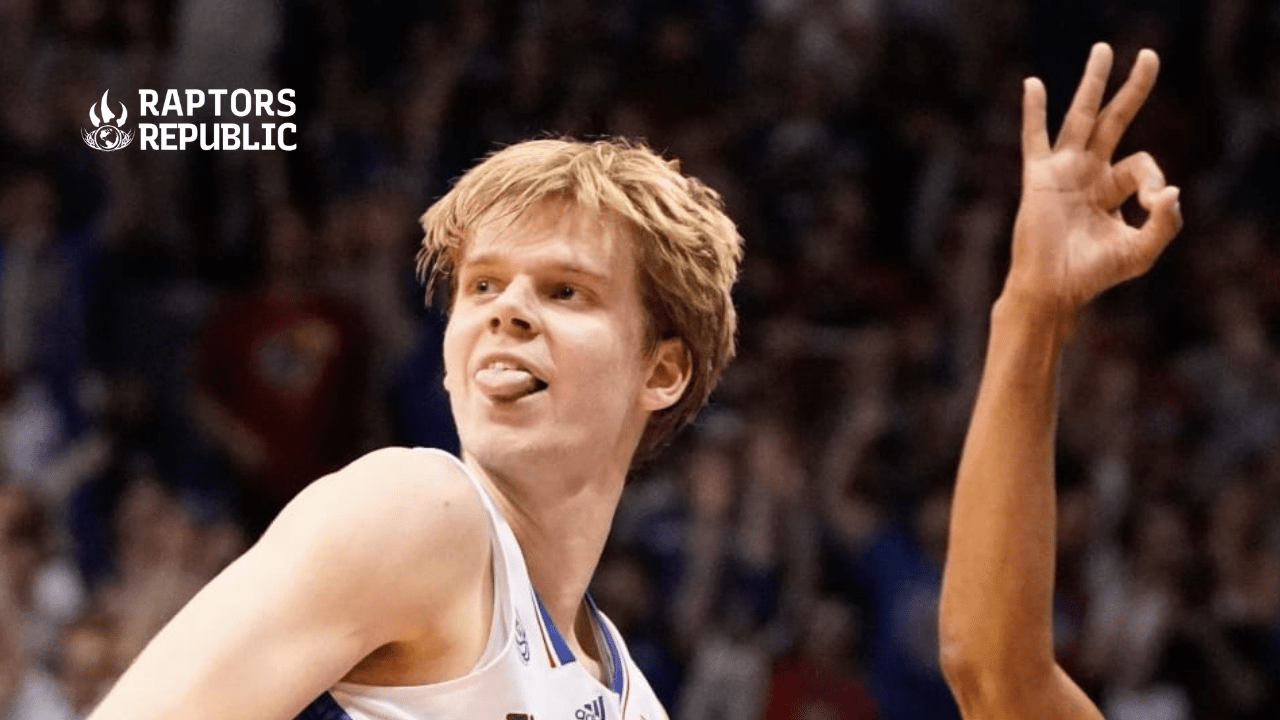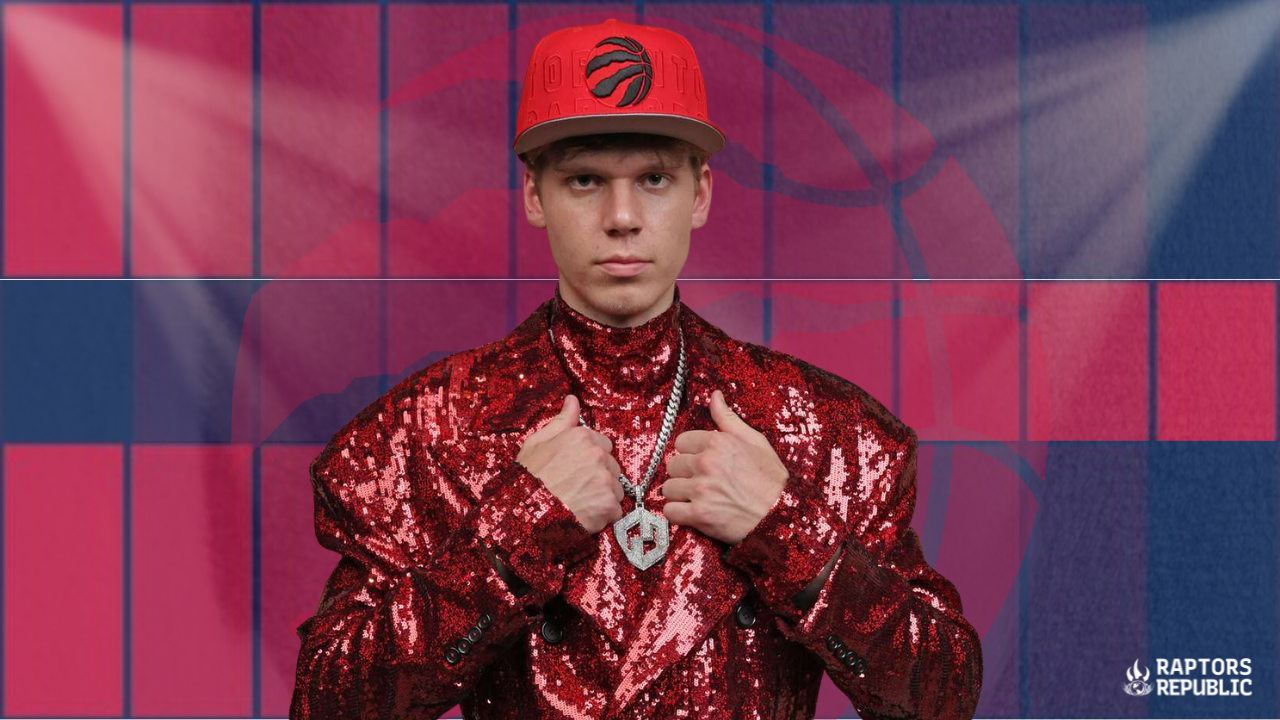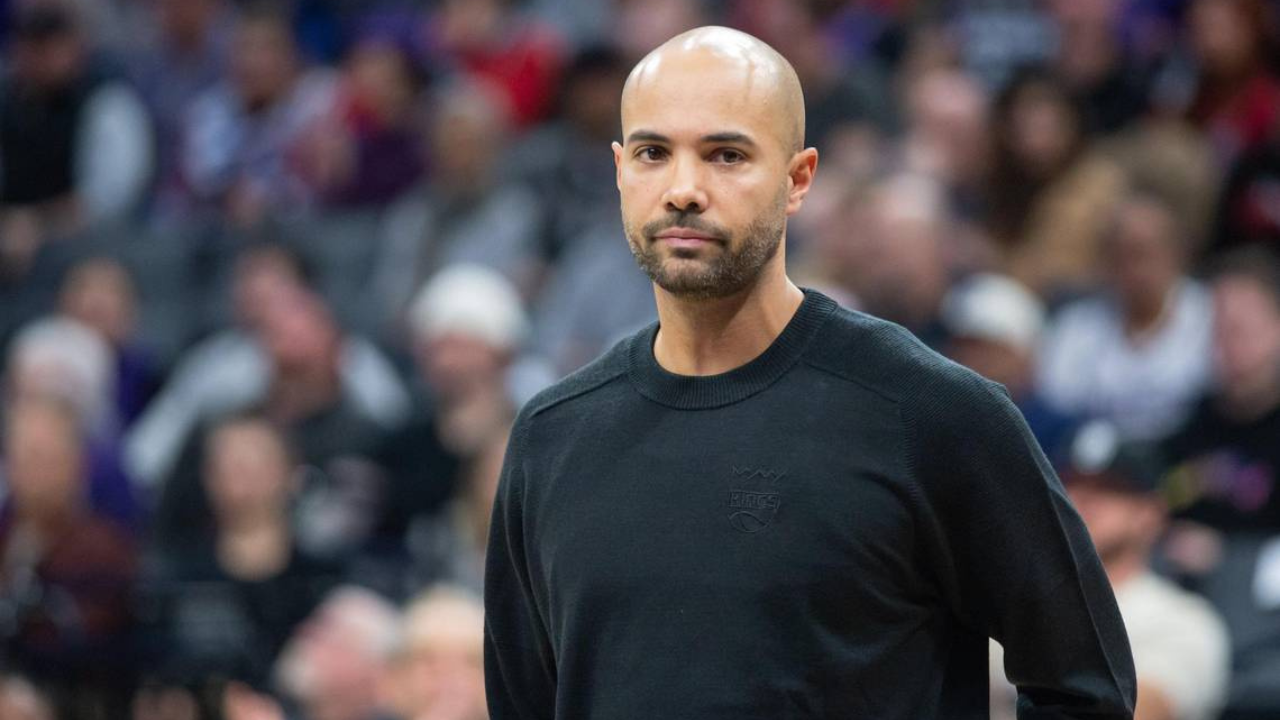Last year, the Toronto Raptors did not lack for talent. However, the relationships between those talented players were, in some ways, partially responsible for Toronto’s underperformance in 2022-23. While players like Scottie Barnes, Pascal Siakam, and Jakob Poeltl all have some skills and abilities that complement one another, the fact that all three are non-shooting bigs means they require extremely specific contexts if they’re going to succeed together. Toronto failed to provide that situation — until now.
Gradey Dick is the first step in the right direction. Selected 13th overall, he is an enormous shooter who moves incredibly well without the ball in his hands. He is the exact type of player Toronto needs to improve the situation around their most important players.
So how will Dick look alongside Siakam and Barnes? What types of plays will they run together? How did Dick perform in those sets in college?
Perhaps the most important component that Dick will provide is the simplest: He is a brilliant shooter. He has a high, fast release, and he doesn’t need any space to get off his shot. Toronto formerly employed three great shooters, and two are short, while the other needs a fair amount of space to get off his shot. Dick could be Toronto’s best shooter from jump street, particularly if Fred VanVleet’s catch-and-shoot accuracy remains good, rather than elite. He just doesn’t need any space at all; he’s a zone-buster all on his own, even if the team has done nothing to shift the defense or create advantages.
Dick will offer that extra room to all his teammates simply by existing on the court. When he’s standing in the corner, the action in the middle of the floor will have more juice. When he lifts or sinks, it will force defenders to pay attention. Because his release is so damn high and fast, when he curls around a pindown, it will shift the defense a little bit more than when anyone else on Toronto’s roster does the same. That will all mean good things. Barnes and Siakam will have more space in the post, more room on the drives, and more time for their shots. It will be fractional, of course, but it will be real.
Those effects are broad and passive. There’s more, of course; the interactions between Dick and his star teammates will become extremely specific and active.
Dick is an elite off-ball mover. He sets up like a wide receiver, chopping his steps — it’s very theatrical. He has terrific footwork setting up his shots, keeping his feet on balance during helter-skelter cuts so that his defender will still be moving when he’s set and catching. And even though he’s slow in terms of straight lines, with the slowest three-quarter sprint measured at the combine, he also recorded the fastest shuttle run. He doesn’t stop moving.
One of Dick’s pet plays is to use an off-ball screen to catch above the screen and pivot immediately into a one-dribble pull-up — turning an off-ball screen into an on-ball screen. To twist the knife, he can do it moving to his left or his right.
If that screener is Barnes, it would annihilate the concept of a defender dropping against Barnes to clog up the paint. Dick would create a wide-open one-dribble triple at will as soon as a center started sagging off Barnes. Furthermore, he scored a ridiculous 1.18 points per shot on jumpers off the dribble, according to Synergy. That ranked 6th in PPS among 494 players with at least 80 jumpers off the dribble last year; of the five with higher PPS off the dribble, the second-tallest was 6-foot-2, while Dick is 6-foot-8. He’s another level of pull-up shooter, more or less incomparable to anyone in college. Dick’s presence alone should mean Barnes has to draw real defensive attention whenever he doesn’t have the ball.
And yet the Jayhawks did not score particularly effectively with Dick cutting with or without a screen. He didn’t play alongside any scorer as dynamic as his Raptor teammates, although teammate Jalen Wilson was selected 51st in the 2023 draft. Barnes and Siakam’s movement and scoring ability will give Dick more space. But some of the blame must lie on Dick’s own shoulders.
He was only average at the rim, shooting 58.8 percent. He is quite big, which helps, but his wingspan is only 2.5 inches longer than his height, which is lesser than the average wingspan-to-height ratio in the NBA. He doesn’t have great vertical, at 34.0 inches, which ranked among the lower half of NBA draftees this year. His arm deceleration isn’t anything to write home about. He takes plenty of wild attempts at the rim, with no real chance at making them. (He does have great touch on six-to-eight foot floaters with either hand.)
As a result, Dick was much less effective when cutting towards the rim than away from it. He frequently found his layups met at the rim, and his points per shot plummeted as soon as his cut took him inside the arc.
That shouldn’t be a huge problem in terms of his relationships with Barnes or Siakam on the court, at least not until Dick becomes a featured player a few years down the road. For now, most of the time, Dick’s role will mostly be curling around off-ball screens, forcing defenders outside towards him. If they overplay him, it should be the screener — Barnes or Siakam — diving to the rim, and both of them are reliable there. If Dick does cut backdoor, it would either create a paint touch for him or an open catch-and-shoot triple for his teammate. That’s good, but not great. The hope has to be for the partnership to enter its final form, Dick has to become a better finisher and a better passer — thus meaning he can turn a paint touch into a pass to another cutting teammate, either towards the rim or for three.
As often than not, when he caught the ball midway through a cut, it ended in awkward shots with the ball going one way and his body another. Still, there were plenty of moments that hinted at what his cuts could become as a successful counter.
But every interaction between Dick and his more established teammates won’t come off the ball. Quite frequently, Dick will run pick and rolls with his teammates, either as the handler or the screener.
The Raptors have a history of running creative variations of pick-and-roll pairings. Their Siakam-Fred VanVleet pick-and-roll has historically been one of their deadliest closing sets, scoring 1.0 points per chance last year. Dick should be an effective screening partner with Siakam, particularly given the low bar Toronto has set when it comes to half-court creation.
He won’t step in and immediately be superior to VanVleet, as the latter has mastered the footwork required to create open shots in ghost screens. And Dick certainly won’t be more effective than VanVleet at catching and putting the ball on the floor to create for teammates. He’s not yet a refined passer (more on that later), and he just doesn’t have the experience yet. He only set two on-ball screens last year for Kansas, per Synergy, and they were clunky. He didn’t display the decisive off-ball movement to which he is accustomed, and he’ll have to get experience in the set for it to become effective.
Still, Dick is enormous at 6-foot-8, and he shot better on guarded catch-and-shoot triples (37.9 percent) to unguarded (35.6 percent) last year. Even without idealized route running, he should still help create open driving lanes for Siakam, particularly as a second-side screener, or even the first screener in a stagger. He has the size to hold up defenders with his screens, and even if he doesn’t pop perfectly, the very notion of him ambling to the perimeter will force defenses to make choices. If he does catch against a switch, he should be able to be effective simply because bigs have to sell out to stop him from shooting.
As a driver, Dick is much more comfortable with his strong hand. He scored significantly better driving right versus left — at 1.12 points per possession versus 0.97. That was because he’s a better shooter moving to his right, as well as a stronger dribbler. He has a much faster first step going right because of the footwork of his shot transitioning to his drive, and he needs that fraction of a second extra to get the jump on his defenders. As a result, he reached the basket approximately 60 percent of the time when driving right versus only a quarter of the time when driving left, per Synergy. Expect to see a large number of Siakam-Dick empty-side pick and rolls — giving Siakam as much space as possible to attack, as well as simplifying Dick’s choices and driving lanes if he catches after popping. (Or, and here’s some specificity, but Dick could space in the left corner for someone else’s pick and roll with Barnes as the roller, who catches short and immediately pivots into a handoff for Dick flying into his right hand with Barnes as his screener and a now-cleared left side around them. Dick would have space for a drive, a pull-up, or a pocket pass to Barnes with no tagger.)
To that point, Dick will likely spend more time as a ball-handler when in actions with Barnes rather than with Siakam. Toronto ran approximately twice as many picks with Siakam handling as with Barnes last year. Furthermore, the specific Barnes-VanVleet action was about one-third as frequent as the Siakam-VanVleet action — although it was equally effective.
In those circumstances, Dick has a long way to go. He only averaged 1.7 assists per game in college, and few of them came out of pick and roll. When he handled in picks, option A, B, C, all the way to the end of the alphabet, was for him to pull up. Now, that could very well have been team design rather than Dick’s preference. And Kansas scored 1.08 points per possession when Dick handled in the pick-and-roll, which was 96th percentile for that playtype and just about the most effective option the Jayhawks had in the half-court. So it worked. But if Dick is going to become more than a scorer at the NBA level, he’ll need to learn to transmute defensive attention on his jumper to creative passers to his rollers.
There were serious flashes, though. Dick needs to tweak his frequency between passing and shooting — or even driving versus simply pulling up from anywhere — but the tools exist for him to be a solid creator. It will take time, likely measured in seasons, not months. But he has passing touch, can read where multiple defenders are on the court, and has an eye to creating single- or not-contested shots for his roller.
Barnes should be a great partner in the pick and roll when Dick is handling. He is fantastic at catching balls thrown all over the gym, so Dick won’t need to be particularly accurate in his pocket passes. And Barnes is fantastic at using open space to create advantages as a passer. Furthermore, he’s not perfect at getting himself open as a screener, with middling angles and timing; Dick’s insane ability as a shooter — 53.5 percent on pull-up triples (albeit on too low a sample size to tell us too much) — should create that extra space for Barnes as a screener. They should be a solid duo, each ameliorating the others’ weaknesses.
Another means through which Dick will help Siakam and Barnes will be in transition. Even if Darko Rajakovic moves away from the run-all-the-time mindset instilled under Nick Nurse, that is the area in which Barnes and Siakam have thrived. Siakam was elite in transition both as the handler and a trailer, whereas Barnes was significantly better as the trailer. Toronto won’t simply stop running. And in the case of either player, Dick’s presence in the open court will be a boon.
Dick is a master assassin in transition. He loves moving into jumpers — given by his seemingly superior off-the-dribble shot versus totally stationary one. He is fantastic at transitioning his kinetic energy from floor to ball, and he has a very flexible and adaptable form.
As a result, he had a PPS of 1.58 on jumpers in the open court on 50 such shots. Only one player in the NBA matched that efficiency on at least 50 such shots (Malik Beasley), so it’s a rare skill. VanVleet finished in 20th there, the highest Raptor, scoring 1.28 points per jumper in transition, which was one of the best offensive outcomes the Raptors could have hoped for last season. If Dick manages to even match VanVleet, let alone surpass him, that will have deep consequences: wider lanes for ballhandlers, more easy baskets for the wings, and an altogether superior offense.
Trent was also just below VanVleet in efficiency on jumpers in transition. If Toronto plays Trent, VanVleet, and Dick together, the other twosome will find a wider court in transition than has existed at Scotiabank since Kyle Lowry haunted the hallways.
There will be mistakes going forward. Dick is a gunner, and he took plenty of ill-advised shots in college that missed the rim by four feet. He takes deep, contested triples. He takes twisting layups that squirt the ball over the backboard. He misses passes. This doesn’t mention the defensive end, where he has extraordinary hands but plenty of weaknesses. Dick is likely to have a negative on/off net rating for long stretches of the season, if not his entire rookie year, simply because rookies make mistakes.
But he is built to fill the exact need the Raptors have. Siakam and Barnes need to be weaponized, and Dick is the ideal threat — he is the powder Toronto needs to pack inside the cannon. Dick will be very hard to keep off the court, largely because so few other players on the roster are able to complement the foundations in Barnes and Siakam to the same extent. Expect him to play 25 minutes a game by the new year — the team will simply need him on the court. Perhaps there are roster changes, and Toronto will acquire other players who can do the same job but with fewer growing pains, allowing Dick to develop slower and with fewer responsibilities. Perhaps the very players Dick best complements will no longer be Raptors.
But for now, Toronto desperately needs Gradey Dick. And he is in the perfect context to radically alter the texture of his team’s offense. Prepare for an extraordinary rookie season.



